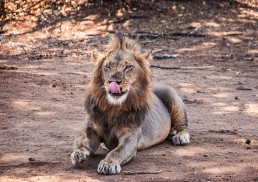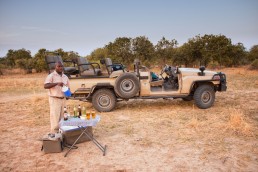One of the biggest questions when preparing for an African safari is: “What should I pack?” We wanted to help you and make sure that after reading this post you will have a comprehensive knowledge about what to bring to be able to enjoy your trip to the fullest, without worrying about your gear.
First of all, just forget the classic “Out of Africa” look from the box office movies and replace it with the convenience and comfort when it comes to the clothing.
Basically, pack like you would pack for an adventure holiday in a warm weather, but there are some specific points to consider when you are going to Africa.
The Clothing for an African Safari
Bring lightweight layers in both long and short lengths of shirts and trousers, sleepwear, swimwear, plus enough pairs of socks.
A warm layer like a sweater or a fleece jacket is a smart idea because the early mornings and late evenings may get chilly in the bush and you don’t want to get cold. Notably, in the highland areas above 5000 feet, it may get extremely crisp at night, in the evenings and early mornings – especially in June, July, and August when the temperatures can be much lower.
So, it is essential to ensure that you pack some items of warm clothing to avoid freezing on game drives in open vehicles. Also, a windbreaker or a light jacket is advisable to take.
Good shoes are vital for your comfort in the long run, though heavy hiking boots are not necessary. A comfortable pair of lightweight trainers is probably your best all-around bet. But some lightweight hiking shoes can still be unbeatable, especially if you’re going on a walking safari in your destination.
We have an exceptionally great example for perfect shoes on a safari: HAIX Black Eagle Athletic Mid –shoes! They are waterproof with Gore-Tex and also come in desert color, which is unbeatable in the scorching sun of Africa – and won’t “cook your feet in sweat” inside them. But, of course, any shoes like these are a good choice.
A hat with a good brim is something you don’t want to leave home! It will protect your face and scalp from the equatorial sun. Sometimes also good sunglasses with 100% UVB/UVA protection are great during the bright, high midday sunlight.
When it comes to the preferable colors to wear, khaki and dark green are always your best bet!
They hide the dust better, which is inevitably going to attach to your clothes in the bush. These colors also blend into the scenery. It is not advisable to wear any bright colors, and black will get you soaked in the sun.
Military-style camouflage prints are the best for blending in, but they are illegal in some parts of Africa so you may better avoid them. Camouflage is also worn by the National Park ‘s rangers, so you may be mixed with them, too. However, we’ve worn camouflage in various parts of Africa without any problems, as they are very comfortable and highly practical clothes to use, but be cautious – you have been warned. If you want to wear some camouflage clothes, it’s best to ask beforehand from your safari tour provider at least about their legal status in your destination country.
And don’t forget a nicer outfit for your time off-safari if you are planning some evenings out in the towns or just want to dress for a casual dinner. This is, of course, optional, but if you’re going to bring a nicer dress, for example, this is the time of days to wear it.
Most camps have laundry facilities, so you can go ahead and pack light. Just a few pieces of each garment will do the trick!
And please, do yourself a favor and pay particular attention to the last point – pack light! You will thank yourself later on. Also, if your itinerary includes flights with the small, lighter aircraft like a 6-10 seat Cessna, they won’t even allow large, bulky, and extra-heavy luggage on board.
The Must-Haves in Your Luggage
Now, let’s move on to the essential items we recommend to always bring with you. These small, but vitally necessary things can even make or break your trip if the circumstances go for it.
Sunblock of preferably 50 SPF is very important! You can buy them on-site, too, but they may be pricey and sometimes past their last recommended “use before” –dates. Just as essential as the sunblock, is a good mosquito repellent! It’ll let you have much more comfortable time, believe us.
Anti-Malaria prophylaxis/tablets of your choice are almost mandatory! Malaria is a nasty decease to recover from and can be practically wholly avoided by just taking the anti-Malaria pills. Nothing can give you a 100% protection, but with taking your anti-Malaria medications and wearing good mosquito repellent will keep you worry-free.
A small, but practical First aid kit with over-the-counter anti-diarrhea medications, motion sickness pills, and a full trip supply of any medicines you take on a regular basis is a must. You can complement your pack with some generic names of painkillers available, too.
Photographers Are in a League of Their Own
Avid photography enthusiasts and professional photographers are in a league of their own, and this subject will require their very own post, for sure. But for the regular photographer, we recommend bringing their camera with several spare batteries and other accessories like chargers, lenses, cleaning kit, memory cards, camera bag, and slings.
As a general rule-of-thumb, though, we would say that bring the longest lens you own with you!
You don’t necessarily need the most expensive and longest focal range lens on the market, but if you can come up with something between 100-300 mm lens you are going to be okay.
The lower your lenses’ f-stop will go, the better. Those lenses with f-stops like f/1.8 or f/2.8 are also the most expensive ones, but you’ll do fine with something like f/4 or, i.e., f/3.5-5.6.
Many safari tour providers have bean bags in their vehicles on which you can stabilize your longer lenses during the photo shootings on the game drives. But you can also take a small, re-sealable, empty canvas bag by yourself and just fill it with rice/rickets or raw beans on-site.
Remember, it’s not about who has the most expensive and fanciest camera gear. It’s about who can take great pictures with any camera gear! Many people take photos with just their phones or pocket camera, and that’s fine, too.
Also, we’d recommend taking an external hard drive to where you can download your shots at the end of every day. This way you don’t need to bring a considerable number of memory cards, and it’s also a good practice to copy your shots every day during a trip. Even large memory capacity hard drives are small and light nowadays. This will, of course, require you bring your laptop with you, too. But nowadays most people will always have theirs with them.
For others, you can cope with, i.e., 3-4 larger capacity memory cards (like 64MB). But if you go this way, we would strongly recommend that you have a water- and dustproof, protecting storage case for the memory cards. Dust and water are deadly for memory cards, too, and you wouldn’t want them to come corrupt! Water- and dustproof card case like this won’t cost you more than about $25 – cheap insurance for your precious safari pictures!
Other Small, Practical Packing Items for an African Safari
Electrical sockets in Africa are many times different from the plugs used in the USA and Europe. Bring an electrical adaptor! These may be harder to find on-site, and if you didn’t charge your phone, camera, and laptop, it would be a huge loss.
A flashlight or a headlamp is an absolute must! And preferably bring lots of extra batteries, too. Even a small pocket flashlight will help you in the dark African evenings, nights, and mornings. A light source is necessary from lighting your way from the dinner to your tent in the more remote bush camps to helping you sort out your camera and other gear on the night or early morning game drives.
Binoculars will make your safari experience more intensive. The guides will always have binoculars with them in the vehicles, and they will let you borrow them, but having your pair is a huge advantage. Sometimes the animals can be even hundreds of yards away, and without binoculars, you won’t be able to spot them. And when it comes to bird watching, they just are an absolute must!
A pocket knife is a handy all-rounder, but you have to remember not ever to have it in your hand luggage!
A small daypack is an excellent choice for many practical uses during your African safari adventure. Taking your camera, water, and other gear with you to the game drives and carrying your gear to the town visits, just to mention a few.
During a safari, you will have early mornings because the best game drives start before the sunrise. Therefore, you should have a reliable alarm clock packed with you.
You may have an alarm clock app on your phone, but just make sure that it won’t run out of battery during the night and leave you sleeping out on your adventures! Many wristwatches have a practical alarm clock function, too.
And lastly, if some seam brakes off of your clothes or something, a sewing kit and small scissors will save your day. Just remember not to have them in your hand luggage.
There you have it, a useful guide to practical packing for your African safari!
If you would like to download a summarized PDF version of this article with an actual packing list with tick-off boxes, you can download it from here!


